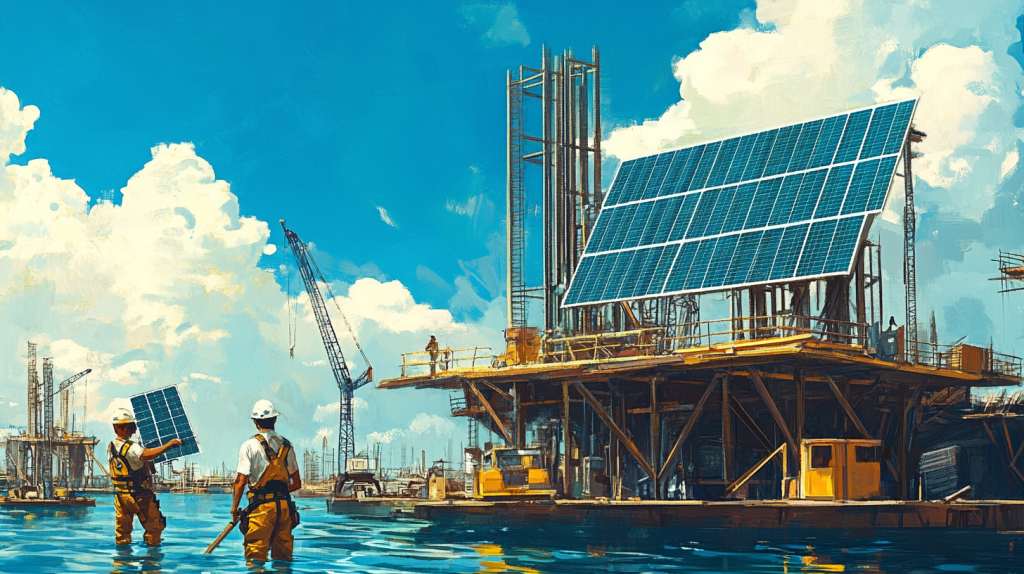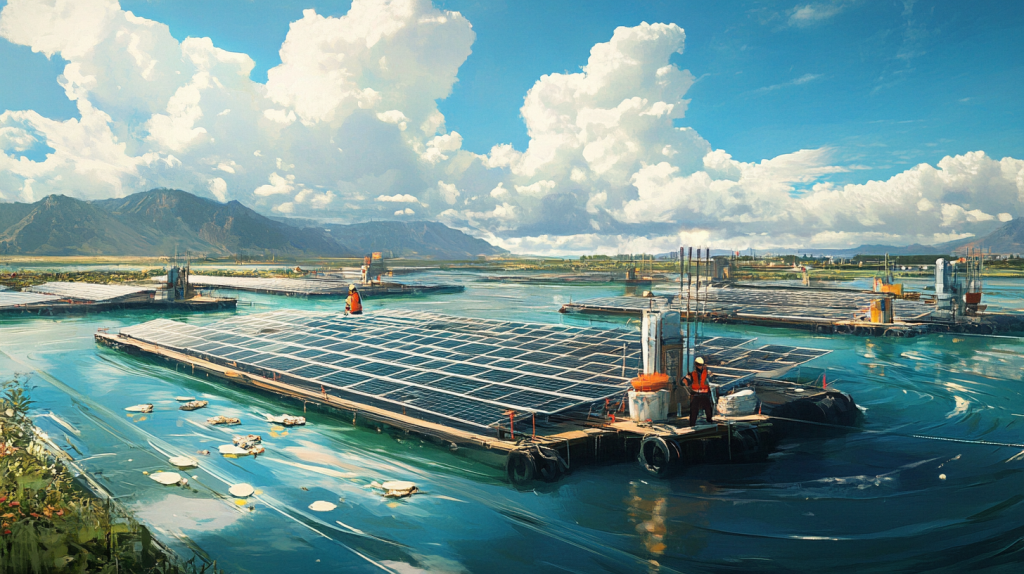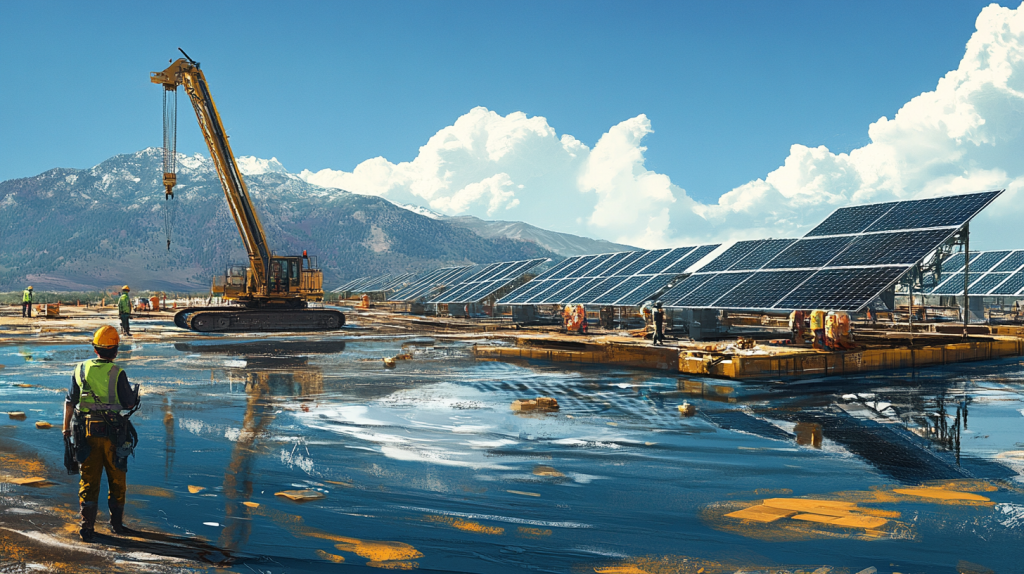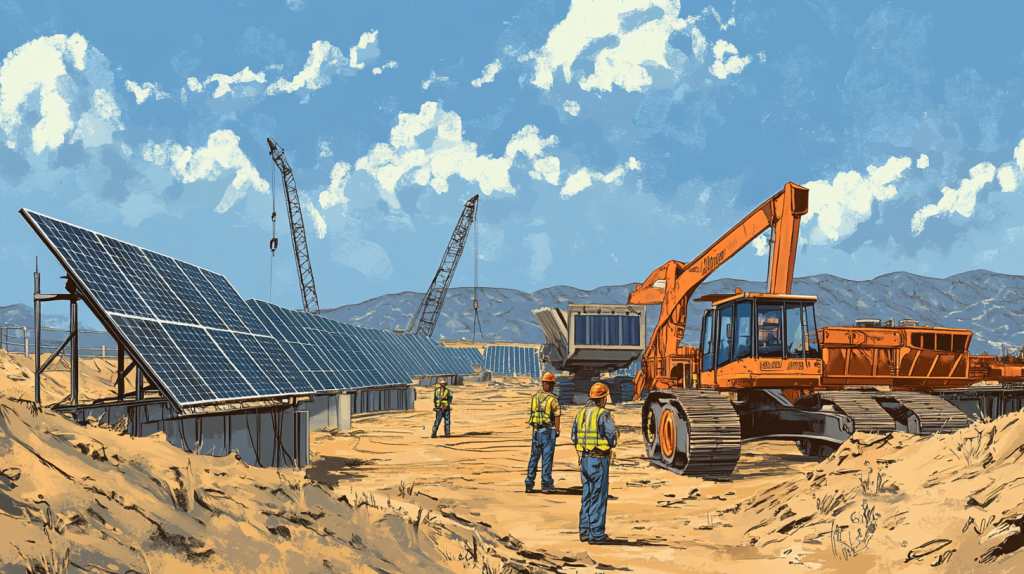Floating Solar Farms: How Offshore Photovoltaics Are Powering the Future of Clean Energy
Table of Contents:

The global transition to renewable energy is accelerating, and floating solar farms are emerging as a game-changer in sustainable power generation. With land availability becoming a growing challenge, offshore photovoltaics (FPV) are redefining how solar energy is deployed, allowing projects to expand into unused water surfaces like reservoirs, lakes, and offshore zones.
Beyond land conservation, floating solar technology is proving to be more efficient than traditional ground-mounted solar panels, offering natural cooling benefits and enhanced energy production. But how viable are floating solar farms, and what are the engineering, logistical, and regulatory considerations for large-scale adoption?
This guide explores the growth of floating solar, its technological advancements, and its impact on land use, grid integration, and energy storage solutions.
What Are Floating Solar Farms and How Do They Work?
Floating solar farms, also known as Floating Photovoltaics (FPV), are solar power systems installed on water bodies instead of land. These systems use floating structures to support photovoltaic panels, allowing solar energy to be harnessed without consuming valuable real estate.
How Floating Solar Farms Operate
- Specialized Floating Platforms – Solar panels are mounted on buoyant structures designed to withstand water currents, wind, and waves.
- Anchoring Systems – The floating panels are anchored to lakebeds, reservoirs, or offshore structures to ensure stability and optimal sun exposure.
- Energy Transmission & Grid Connection – The generated electricity is transmitted through underwater cables or hybrid energy storage solutions for grid integration.
Advantages of Floating Solar Over Traditional Ground-Based Systems
✅ Optimized Land Use – Avoids conflicts over agricultural and urban land use.
✅ Increased Energy Efficiency – Natural cooling from water increases panel efficiency by 5-10% compared to ground-based systems.
✅ Reduced Evaporation – Floating solar prevents excessive water loss in reservoirs, making it beneficial for water conservation efforts.
Floating solar technology is a breakthrough innovation in the solar industry, allowing renewable energy projects to scale beyond land constraints while improving efficiency and sustainability.

The Rise of Floating Solar in Global Energy Markets
The demand for floating solar is rapidly increasing, with several large-scale projects already deployed worldwide. Countries facing land scarcity, high population densities, or limited renewable expansion areas are leading the way in FPV adoption.
Global Trends in Floating Solar Deployment
- Asia Leading the Charge
- China, India, Japan, and South Korea are investing in massive floating solar installations to expand their renewable energy capacity without disrupting farmland or urban space.
- China’s Three Gorges Reservoir Floating Solar Project is the world’s largest FPV installation, generating over 850 MW of clean energy.
- Europe and the U.S. Entering the Market
- The Netherlands has developed floating solar farms across artificial lakes to maximize energy production in limited land areas.
- The United States is piloting FPV on hydroelectric dams and water reservoirs, reducing transmission losses and enhancing energy grid stability.
- Offshore Floating Solar: The Next Frontier?
- Recent advancements in offshore floating solar farms are exploring how FPV can be co-located with offshore wind farms, improving renewable energy efficiency in ocean environments.
Floating solar is gaining global traction, with countries leveraging water-based solar farms to increase clean energy production while minimizing land use conflicts.
Related Articles:
Floating Solar Power: Harnessing Water for the Future of Renewable Energy

Challenges and Engineering Considerations for Floating Solar
While floating solar offers huge advantages, there are technical and logistical challenges that developers must overcome to scale FPV projects successfully.
Key Challenges in Floating Solar Farm Deployment
- Structural Integrity and Weather Resilience
- Floating solar farms must withstand wave movements, strong winds, and water level fluctuations.
- Engineering solutions include stronger anchoring systems and lightweight, corrosion-resistant materials.
- Environmental and Ecological Impact
- FPV systems can alter aquatic ecosystems by affecting oxygen levels and water temperatures.
- Careful site selection and environmental monitoring are required to minimize negative effects.
- Grid Integration and Energy Storage
- Offshore solar farms require advanced energy transmission solutions, such as underwater power cables and floating battery storage.
- Hybrid systems that combine floating solar with hydroelectric dams or offshore wind are emerging as a viable solution for continuous renewable energy supply.
The success of floating solar depends on strong engineering solutions, sustainable site selection, and innovative grid integration technologies, ensuring long-term energy reliability and ecological balance.
The Role of AI and Automation in Floating Solar Construction
As floating solar farms scale up worldwide, the integration of artificial intelligence (AI) and automation is becoming essential for improving installation efficiency, maintenance, and operational oversight. Traditional solar farm construction methods rely heavily on manual labor and mechanical assembly, which can lead to delays, inefficiencies, and higher costs. AI-powered automation is changing the game, making floating solar deployment faster, more precise, and cost-effective.
How AI and Automation Are Transforming Floating Solar Construction
1. AI-Driven Design and Optimization
- AI algorithms analyze weather patterns, water body characteristics, and solar angles to determine the best panel layout for maximum energy efficiency.
- Machine learning models predict wave movement and water level fluctuations, allowing engineers to design more stable floating structures.
2. Robotic Assembly and Installation
- Automated robots are being used to assemble and install floating solar panels, reducing the need for large on-site labor teams.
- In large-scale projects, AI-powered robotic arms can attach and align solar panels with extreme precision, reducing human error.
3. Predictive Maintenance and Remote Monitoring
- AI-driven analytics detect early signs of wear, corrosion, or potential system failures, preventing costly repairs.
- Drones equipped with thermal imaging cameras monitor solar panel performance and pinpoint inefficiencies in real time.
Best Practices for AI and Automation in Floating Solar Projects
✅ Use AI-based modeling software to optimize floating solar farm designs.
✅ Implement robotic-assisted panel installation to speed up deployment.
✅ Leverage AI-powered predictive maintenance to extend the lifespan of solar installations.
AI and automation are revolutionizing floating solar construction, making projects more cost-efficient, scalable, and resilient against environmental challenges.

Land Use vs. Water Use: Comparing Floating Solar to Ground-Mounted Systems
One of the biggest debates in renewable energy infrastructure is the trade-off between land-based and water-based solar farms. While ground-mounted solar has been the industry standard, floating solar offers unique benefits that make it an attractive alternative, particularly in regions with land constraints.
Key Differences Between Floating and Ground-Mounted Solar
| Feature | Floating Solar Farms | Ground-Mounted Solar |
| Land Use | Does not require land; installed on reservoirs, lakes, or offshore areas. | Requires large land tracts, often competing with agriculture and real estate. |
| Energy Efficiency | Natural cooling from water increases panel efficiency by 5-10%. | Panels can overheat, reducing energy output in high-temperature climates. |
| Installation Costs | Higher initial setup due to floating infrastructure. | Lower installation costs but requires land acquisition. |
| Environmental Impact | Helps reduce water evaporation and prevent algae overgrowth. | Can disrupt ecosystems and may require deforestation. |
| Maintenance | Requires specialized waterproof electrical systems and corrosion-resistant materials. | Easier to maintain but vulnerable to soil erosion and land degradation. |
When Is Floating Solar the Better Choice?
✅ Regions with limited land availability, such as urban areas or islands.
✅ Reservoirs, hydroelectric dams, and industrial water bodies where solar farms can coexist with existing infrastructure.
✅ Hot climates where panel cooling can increase energy production efficiency.
Floating solar is an innovative solution for regions where land use is a major constraint, while ground-mounted solar remains a more affordable option for large, undeveloped land areas. The future of solar energy will likely involve a hybrid approach, utilizing both land-based and water-based solar farms.
How Smart Construction Software Optimizes Floating Solar Projects
While floating solar farms offer massive potential, they come with complex logistical challenges that require advanced construction management tools to execute effectively. Managing offshore solar installations, tracking large-scale material deliveries, and ensuring regulatory compliance require real-time data, automation, and seamless coordination across multiple stakeholders.
This is where smart construction software plays a crucial role in simplifying project execution and improving efficiency.
Key Benefits of Using Smart Construction Software for Floating Solar
1. Managing Complex Supply Chain Logistics
- Floating solar farms require specialized equipment, anchoring systems, and modular floating structures that must be transported to remote or offshore locations.
- StruxHub provides real-time tracking of solar panel shipments, ensuring materials arrive on time and in the right sequence for installation.
2. Workforce Scheduling and Remote Collaboration
- Since floating solar farms are built on reservoirs, lakes, or offshore areas, construction crews need precise scheduling to optimize workforce efficiency.
- Smart scheduling tools automate crew assignments, ensuring that labor teams arrive only when materials and equipment are ready for installation.
3. Compliance Tracking and Permitting Management
- Floating solar projects must comply with environmental impact regulations, water-use permits, and electrical grid connection approvals.
- StruxHub’s compliance tracking system automatically updates project teams on upcoming regulatory deadlines, ensuring all permits are secured before construction begins.
4. Site Monitoring with AI and IoT Integration
- Drones and IoT sensors are increasingly used to monitor floating solar sites for structural integrity and panel performance.
- StruxHub integrates AI-powered analytics, allowing project managers to detect panel misalignments, weather-induced stress, or water level fluctuations in real time.
Best Practices for Using Smart Software in Floating Solar Projects
✅ Implement real-time delivery tracking to manage offshore logistics.
✅ Use automated workforce scheduling to optimize labor deployment.
✅ Ensure all regulatory documents and environmental permits are digitally stored and updated.
The complexity of floating solar projects requires advanced digital solutions to manage supply chain logistics, workforce scheduling, and compliance tracking. StruxHub provides the essential tools for ensuring that floating solar farms are executed on time, on budget, and in full regulatory compliance.

Energy Storage Challenges and Solutions for Floating Solar Farms
Floating solar farms offer a reliable source of renewable energy, but intermittency remains a major challenge. Since solar power generation fluctuates based on weather conditions and daylight availability, effective energy storage solutions are essential for ensuring consistent power supply and grid stability.
Key Energy Storage Challenges in Floating Solar
- Intermittent Energy Production
- Floating solar panels generate electricity only when the sun is shining, leading to energy supply fluctuations.
- Cloud cover, seasonal variations, and night-time downtime reduce efficiency.
- Limited On-Site Storage Capacity
- Unlike land-based solar farms, floating solar projects face unique space constraints when integrating battery storage.
- Installing battery storage solutions on floating structures introduces engineering challenges related to weight distribution and waterproofing.
- Grid Integration and Transmission Losses
- Floating solar farms often require underwater transmission cables to connect to the main power grid, increasing energy losses.
- Grid balancing issues arise when large amounts of solar energy are injected into the system without proper energy storage buffers.
Innovative Energy Storage Solutions for Floating Solar Farms
- Hybrid Floating Solar + Hydropower Integration
- Co-locating floating solar with hydroelectric dams provides a natural energy storage solution.
- Excess solar energy is used to pump water into reservoirs, which can later be released for hydropower generation when needed.
- Advanced Battery Storage Technologies
- Lithium-ion batteries are commonly used but have limited lifespan and environmental concerns.
- Flow batteries and sodium-ion batteries are emerging as more sustainable, longer-lasting alternatives for solar energy storage.
- Floating Battery Storage Systems
- Some projects are exploring floating energy storage units, which allow batteries to be integrated with floating solar structures, reducing land use and enhancing system efficiency.
Best Practices for Energy Storage in Floating Solar
✅ Integrate floating solar with existing hydropower stations to maximize grid stability.
✅ Adopt new battery technologies that offer higher energy density and faster charging capabilities.
✅ Optimize energy distribution with AI-based demand forecasting to prevent grid overloads.
The future of floating solar depends on energy storage advancements that ensure reliable, round-the-clock power generation. Hybrid energy solutions, next-gen batteries, and AI-driven grid management will play a critical role in making floating solar a viable, large-scale renewable energy source.

Policy and Regulatory Considerations for Floating Solar Expansion
As floating solar farms expand, governments and regulatory agencies are developing new policies to govern water use, environmental impact, and energy integration. These regulations shape project feasibility, permitting processes, and long-term scalability.
Key Regulatory Challenges in Floating Solar
- Water Rights and Land Use Conflicts
- Some jurisdictions restrict the use of water bodies for commercial energy production, requiring special permits.
- Conflicts with fishing, irrigation, and wildlife protection policies can limit project locations.
- Environmental Impact Regulations
- Floating solar farms can disrupt aquatic ecosystems, affecting water quality, oxygen levels, and biodiversity.
- Regulatory frameworks require environmental impact assessments (EIA) to prevent ecological damage.
- Grid Interconnection and Energy Distribution Laws
- Floating solar projects must comply with grid interconnection standards and power purchase agreements (PPAs).
- Some governments offer incentives for floating solar integration, while others impose strict grid reliability measures that require advanced storage solutions.
Emerging Policy Trends Supporting Floating Solar
- Government Incentives and Tax Credits
- Many countries are offering tax benefits and subsidies for floating solar developers, accelerating adoption.
- The U.S. Inflation Reduction Act (IRA) has allocated funding for floating solar pilot projects as part of a broader clean energy push.
- Sustainable Development Requirements
- The European Union’s Renewable Energy Directive requires floating solar projects to meet strict sustainability criteria, including biodiversity protection measures.
- Streamlined Permitting Processes for Floating Solar
- In regions like Asia and South America, governments are simplifying floating solar permitting to encourage rapid deployment.
Best Practices for Regulatory Compliance in Floating Solar
✅ Conduct environmental impact studies early in the planning phase.
✅ Engage with local communities to address water use concerns.
✅ Work with government agencies to secure incentives and meet compliance standards.
As policies evolve, floating solar developers must stay ahead of regulatory requirements to ensure smooth project approvals, minimize environmental risks, and maximize economic benefits.

The Future of Floating Solar: Offshore Expansion and Hybrid Energy Systems
Floating solar farms are expanding beyond reservoirs and inland lakes into offshore environments, where they can co-exist with offshore wind farms to create hybrid renewable energy hubs. The combination of floating solar, wind power, and energy storage is shaping the next generation of sustainable energy solutions.
The Rise of Offshore Floating Solar
- Co-Locating Floating Solar with Offshore Wind Farms
- Combining floating solar panels with offshore wind turbines maximizes energy production by leveraging complementary generation cycles.
- Offshore solar panels generate power during daylight hours, while wind turbines produce energy at night and in cloudy conditions.
- Floating Solar for Remote Islands and Coastal Communities
- Many remote islands rely on diesel generators, making offshore floating solar a cleaner, more sustainable alternative.
- Countries like Singapore and Indonesia are investing in large-scale floating solar farms near coastlines.
- Next-Generation Floating Solar Technology
- Wave-resistant floating solar platforms are being developed to withstand offshore conditions.
- Hybrid energy storage solutions, such as saltwater batteries and green hydrogen production, could enhance energy resilience.

StruxHub
Experience the power of StruxHub today and witness firsthand how it can revolutionize your construction operations.
Best Practices for Offshore Floating Solar Development
✅ Pair floating solar with offshore wind farms to create hybrid energy solutions.
✅ Invest in wave-resistant anchoring systems to ensure long-term durability.
✅ Explore new energy storage technologies to stabilize offshore power generation.
Offshore floating solar represents the next frontier in renewable energy, providing a scalable, efficient solution for coastal regions, islands, and hybrid energy projects. With advancements in technology and policy support, offshore FPV is set to play a key role in global decarbonization efforts.
Unlock the Full Potential of Your Construction Projects with StruxHub
StruxHub enhances efficiency and coordination across all project phases, providing a single source of truth that eliminates silos and fosters collaboration. Real-time updates, financial management tools, and seamless commvunication features ensure that all team members and stakeholders are aligned and informed, reducing the risk of errors and delays. With comprehensive solutions for document management, risk mitigation, and quality control, StruxHub maintains project integrity and safety, while mobile access and integration capabilities further enhance project flexibility and efficiency.
StruxHub’s Key Features and Benefits:
- Advanced Delivery Management: Automate and optimize your delivery schedules, ensuring materials arrive just in time, every time.
- Site Communication: Utilize georeferenced maps and instant messaging to keep every team member informed and aligned.
- Construction Materials Management: Track inventory levels and manage materials procurement with ease, reducing waste and avoiding project delays.
- Construction Safety & Inspection Workflows: Implement customizable mobile forms for conducting safety inspections and managing compliance documentation effortlessly.
- Short-Term Scheduling: Visualize project tasks with detailed floor plans, linking each activity to specific locations for better planning accuracy.
- Construction Resource Management: Efficiently allocate personnel and equipment, maximizing productivity and reducing idle time.
StruxHub’s Product Offering:
- StruxHub Deliveries: Simplifies the coordination of incoming deliveries, ensuring materials and equipment are precisely timed to project needs.
- StruxHub Logistics: Offers intelligent site logistics planning, from crane scheduling to space allocation, for smoother operations.
- StruxHub Safety: Elevates on-site safety standards with easy-to-use tools for inspections, permits, and incident reporting.
- StruxHub Scheduling: Enhances project timelines with intuitive scheduling tools that ensure tasks are completed efficiently and on time.
With StruxHub, construction companies can look forward to a streamlined, more efficient project execution that delivers on time and within budget. Embrace the power of innovation and take your construction projects to the next level.
Don’t miss out on the opportunity to optimize your construction management processes with StruxHub. Sign up for a free demo today. Let’s build smarter, together.




